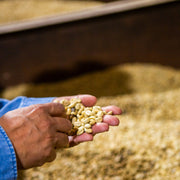Ever wonder how every single rice grain in a bag of rice is consistent in color, shape, and size? Or peanuts? Beans? Corn? Coffee? An optical sorter sorts them!
In 2018, Counter Culture Coffee became the first specialty coffee roasting company to utilize optical sorting technology in post-roast quality control of its coffees. This is a technology that has long existed in a variety of commodity value streams to guarantee consistency of the finished product.
In the coffee industry, a large percentage of the unroasted green coffee goes through an optical sorter before export. This is why it arrives at the roastery so beautiful and consistent. But post-roast optical sorting is a very new to the process. And we were the first to try it!

How Does An Optical Sorter Work?
An optical sorter works kind of like a very fast, very observant eye, programmed to identify the correct color, shape, and size of your product – in our case, coffee! Roasted coffee is poured past the eye at very high speeds out of a hopper. Any coffee beans that don’t meet the set standards are - poof! - blown out of the stream by a puff from a precise pressurized air gun. We use a Bühler Sortex at our East Coast roastery and a Satake Optical Sorter on the West Coast.

Why Is Optical Sorting Necessary?
Specialty coffee has been getting along fine all these years, right? In short, yes! Whether our coffees are sorted after roasting or not, they taste delicious. A LOT of care goes into preparing them for shipment. In countries that produce green coffee, exporters use density tables, hand-sorting, and optical-sorting machines to prepare our coffees to the highest standards. Optical sorting after roasting is just another opportunity for us to add value and push potential.
Sorting Out The Quakers
Sorters like the ones we’re using can catch all kinds of things; obvious ones, like foreign objects (no more “how’d this wrench get in here?!”); but when we are sorting, we are primarily looking for quakers. In coffee, when we say quaker, we aren’t talking about oatmeal.

What Is A Quaker?
Coffee quakers are beans that develop much slower in the roaster because their fruit didn’t produce enough sugar while on the coffee plant. They turn bright yellow or tan while the rest of the coffee turns brown. This can happen when coffee is picked underripe, but it is possible to pick a coffee cherry that looks perfectly ripe and still get a quaker.
Diseases that affect plant health, like leaf rust, definitely cause quakers. We have seen a significantly higher number of quakers in coffees whose trees suffered from that disease.
Fun Fact: No one knows for sure why they are called quakers. Seriously!
Tuning The Optical Sorter
Tuning the optical sorter is a tricky job. Make its tolerances too strict, and it will start rejecting perfectly good coffee beans. Too broad, and it will allow a lot of quakers through. Our goal is to have a 97 percent reduction in quakers. That doesn’t mean we get every single quaker, nor does it mean that all of the removed coffee is imperfect. But it dramatically lowers the instance of quakers, improving the consistency and flavor of your coffee.
We’re removing .5-5% of any particular coffee, with more quakers being removed from naturally processed coffees than washed coffees. Nothing goes to waste, though! We re-roast the rejected coffee (sometimes called a “swiss roast”) and then donate that coffee to local organizations.
While eliminating quakers is our primary goal, using an optical sorter is very new in post-roast coffee, and other opportunities are being explored. Any technology we can use on our end to improve coffee quality and take some of that burden off of our producer partners is good for the value stream. We are excited about the possibilities!






